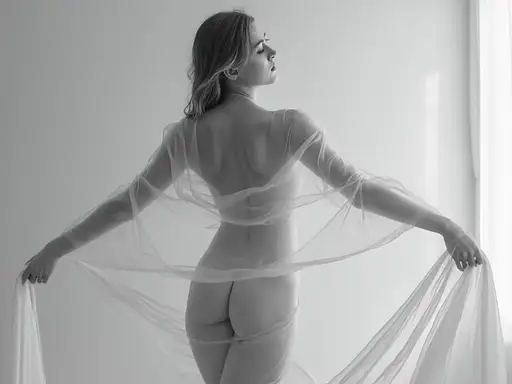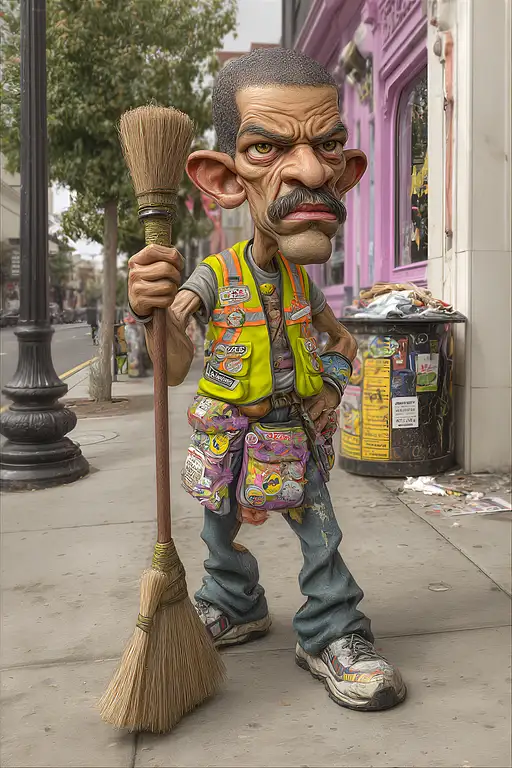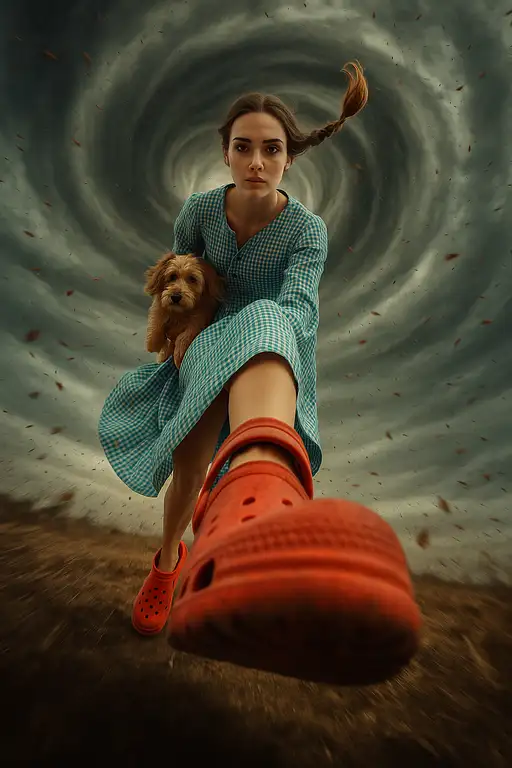


9 months ago
a high-resolution image that captures the essence of a dynamic character in a futuristic setting. she is an shining AI that her face looks like human. she is wearing metal suit, platinum blonde flowly hair ,The character is poised. Standing posing slightly turned with her head facing you, energetically, with flowing garments suggesting motion. Incorporate a vivid color scheme with pink, and reflective silvers, reminiscent of nightcore aesthetics. Use dramatic backlighting to emulate a neon glow, contrasting with the darker hues of a cosmic backdrop , she is bright , The image should mimic the depth of field and clarity with sharp focus on the character and a blurred background. Add realistic textures to the character's clothing and hair, and include a visible light source in their hands, producing a gleaming, otherworldly effect. Ensure the overall composition resembles a candid snapshot, capturing a spontaneous moment of action in a surreal, sci-fi universe, Her eyes are purple, her entire body, GoPro HERO10 Black, Cinestill 800T, cyberpunk, a cinematic scene, --ar 9:16 --s 750. Holographic, chroma

9 months ago
a high-resolution image that captures the essence of a dynamic character in a futuristic setting. she is an shining AI that her face looks like human. she is wearing metal suit, platinum blonde flowly hair ,The character is poised energetically, with flowing garments suggesting motion. Incorporate a vivid color scheme with pink, and reflective silvers, reminiscent of nightcore aesthetics. Use dramatic backlighting to emulate a neon glow, contrasting with the darker hues of a cosmic backdrop , she is bright , The image should mimic the depth of field and clarity with sharp focus on the character and a blurred background. Add realistic textures to the character's clothing and hair, and include a visible light source in their hands, producing a gleaming, otherworldly effect. Ensure the overall composition resembles a candid snapshot, capturing a spontaneous moment of action in a surreal, sci-fi universe, Her eyes are purple, her entire body, she is reaching out towards you, GoPro HERO10 Black, Cinestill 800T, cyberpunk, a cinematic scene, --ar 9:16 --s 750. Holographic, chroma

9 months ago
Eira "Frost" Valen from the Glacial Guard, exudes a cool, elegant poise with her long, platinum blonde hair styled into an intricate braid. Her face is exquisitely detailed, featuring serene, ice-blue eyes and a calm, yet focused expression. She wears a cutting-edge, white cryo suit with a sleek, streamlined design, accented with glowing cyan and blue energy lines and transparent ice shields around her arms. The scene captures Eira mid-slide down a colossal, snow-covered mountain, surrounded by a blizzard of swirling snow and ice. Ice crystals glimmer as she navigates the icy terrain, and her cryo suit shines under the diffused light, highlighting her lithe and athletic form. The setting combines realism with a sci-fi Arctic aesthetic, emphasizing motion, light, and stark beauty.

9 months ago
A hyper-realistic, cinematic scene of a man driving a sleek, black Lamborghini through a dark, midnight cityscape. The car is in motion, its polished surface reflecting the faint glow of distant city lights. The focus of the composition is the man’s face, captured in stunning detail as he leans slightly out of the open driver-side window. His expression is confident and charismatic as he holds out a high-tech smartphone in one hand, taking a selfie. The background is a symphony of motion blur, with streaks of warm, golden streetlights and faint neon glows from nearby signs blending into soft, dynamic trails, emphasizing the speed of the car. The road is dark, wet with a faint sheen as though from a recent rain, subtly reflecting the light trails and enhancing the atmosphere. A beautiful bokeh effect blurs the distant city lights, adding depth and emphasizing the sharp focus on the man’s face. His features are well-lit by the soft glow of his smartphone screen, casting a subtle, flattering light on his expression while the rest of the scene remains shadowy and moody. The darkened interior of the Lamborghini is visible but minimalistic, allowing the viewer to focus on the man and the dynamic energy of the moment. The overall tone is sleek, modern, and cinematic, capturing the thrill of speed, the intimacy of the selfie, and the dark beauty of the city at night.

6 months ago
An ultra-realistic, high-definition 8K image of a man holding a camera in his hand, taking a selfie while running at full speed, with a massive black bear chasing him from behind. The man is mid-stride, his body angled slightly forward, clearly pushing himself to his physical limits to escape. His facial expression is a mix of pure terror and adrenaline, with wide-open eyes and his mouth in a scream or shout. Sweat drips down his face, and his clothes are slightly disheveled from the intense movement. The black bear behind him is enormous and menacing, with sharp teeth bared and powerful muscles visible beneath its thick, glossy fur. Its claws dig into the dirt as it charges aggressively. The proximity between the man and the bear creates an edge-of-your-seat tension. The scene is shot in a dramatic GoPro-style wide-angle perspective, emphasizing the man in the foreground while showing the bear looming in the background. Motion blur enhances the feeling of high-speed movement, with the dense forest around them slightly out of focus due to the action. The forest features tall trees with sunlight filtering through the canopy, casting dappled light and shadows. The ground is covered with leaves, dirt, and roots, creating a dynamic, rugged environment. Every detail, from the man's sweat to the bear's fur and the forest's textures, is rendered with photorealistic clarity. The overall atmosphere is intense, cinematic, and adrenaline-fueled.

9 months ago
a high-resolution image that captures the essence of a dynamic character in a futuristic setting. she is an shining AI that her face looks like human. she is wearing metal suit, platinum blonde flowly hair ,The character is poised energetically, with flowing garments suggesting motion. Incorporate a vivid color scheme with pink, and reflective silvers, reminiscent of nightcore aesthetics. Use dramatic backlighting to emulate a neon glow, contrasting with the darker hues of a cosmic backdrop , she is bright , The image should mimic the depth of field and clarity with sharp focus on the character and a blurred background. Add realistic textures to the character's clothing and hair, and include a visible light source in their hands, producing a gleaming, otherworldly effect. Ensure the overall composition resembles a candid snapshot, capturing a spontaneous moment of action in a surreal, sci-fi universe, Her eyes are purple, her entire body, she is reaching out towards you, GoPro HERO10 Black, Cinestill 800T, cyberpunk, a cinematic scene, --ar 9:16 --s 750. Holographic, chroma

2 months ago
A minimalist black-and-white photograph of a nude woman, her face and body elegantly obscured by long, flowing sheer fabric that wraps around her form and stretches outward, extending beyond the frame. The fabric billows softly in the air, as if suspended in motion, creating a sense of grace and fluidity. The woman's arms are outstretched, with the fabric draping fluidly around her, framing her body while revealing subtle hints of her silhouette. Her body is slightly turned, creating an abstract, statuesque silhouette that exudes serenity and elegance. Soft, diffused lighting enhances the delicate texture of the sheer fabric and the gentle curves of her skin, casting subtle, graceful shadows that add depth and softness to the composition. The background is a smooth, pale wall, devoid of distractions, keeping the focus entirely on the interplay between the flowing fabric and the woman’s figure. The fabric appears weightless as it stretches outward, suggesting a connection to something beyond the frame, adding a sense of mystery and movement. The image is captured in high resolution with a slight film grain, lending the photograph a timeless, cinematic quality. The overall mood is ethereal and elegant, with the flowing fabric contributing to a dreamlike, abstract sense of beauty

9 months ago
A photo of pretty 1/2 human - 1/2 robot Asian Cyborg girl with long, with an absolutely symmetrical face, perfectly styled highlighted brown hair in a ponytail. She wears crop-top and low waist hi-tech ceramic armor. She's standing with a black and white snake wrapping around her torso. Captured with professional camera settings: f/1.8 aperture, ISO 50, 1/250s shutter speed, 85mm prime lens, professional portrait settings, in the style of commercial photography, with studio lighting creating soft shadows and clean sharp focus in a cinematic style of photography. The shallow depth of field enhances the subject while softly blurring the background, ensuring that both her face and outfit are impeccably detailed and in focus. The composition incorporates a professional angle that emphasizes her posture and outfit, with a cinematic touch to highlight her natural grace and sophistication. Ultra-realistic, portrait, shot with top of the line Canon DSLR, high quality, bokeh effect emphasizing the outfit and grace of the dancer, blurred motion background.

5 months ago
A dramatic, front-facing close-up portrait of Mariano Rajoy in a suit, reminiscent of the T-1000 from Terminator 2. The composition is perfectly symmetrical, with his face divided vertically into two distinct visual styles. The left half is hyper-realistic, emphasizing lifelike skin textures, sharp cheekbones, and piercing, determined eyes under cinematic lighting that enhances his cold, authoritative presence. The right half is a seamless transformation into liquid metal — smooth, reflective, and in constant, subtle motion — evoking a futuristic, shape-shifting machine. His expression is calm, composed, and exudes quiet menace and unshakable focus. The division between the two halves is jagged and organic, like torn steel or cracking ice, symbolizing the fusion of human form and advanced technology. A muted, minimal background ensures all focus remains on his iconic, intimidating face, highlighting the stark contrast between man and machine.

4 months ago
The Joker, Caucasian male, mid-30s, wearing a classic purple pinstriped suit, orange waistcoat, and teal-spotted cravat. He wears a purple fedora. He is grinning maniacally. He holds a handgun, and is in a dynamic, fast-moving pose, as if in mid-stride, suggesting action and a sense of urgency. The lighting is dramatic, with strong shadows and highlights, showcasing the rich details of the clothing and the character's expression. The background depicts a city street scene with posters and signs. The colors are vivid and bold, with deep purples, vibrant teals, and oranges. The style is comic book art, with a painterly quality and detailed textures on the fabric. A smoky or foggy effect surrounds the Joker, emphasizing his motion and creating a dramatic atmosphere. The perspective is a slightly low-angle shot, focusing on the Joker's dynamic movement, with a medium close-up view. The overall mood is energetic, intense, and slightly menacing, reflective of the character's personality. Ultra detailed, comic book style, highly stylized, cinematic lighting, realistic fabrics

6 months ago
Abstract Full-Body Portrait of a Prostitute – Salvador Dalí (Late-Life Style, Singular Focus & Pure Surrealism) (Surrealism:1.7, Salvador Dalí late-life style:2.0, Dreamlike distortion:1.6, Hyperreal textures:1.5, Chiaroscuro contrast:1.4, Oil-painting brushstrokes:1.5, Organic fluidity:1.6, Metaphysical realism:1.4) A full-body surrealist portrait of a prostitute, painted in the unmistakable late-life style of Salvador Dalí, where dream logic dictates form and reality bends into its own subconscious reflection. She stands alone in the void, a lone figure frozen in motion yet melting into time itself. Her body is elongated but coherent, her limbs refined into one singular, fluid, organic motion, as if she is a sculpture made of half-formed candle wax, melting at the edges but never fully dissolving. Her face remains untouched by distortion, hyperreal and melancholic, eyes darkened with kohl, staring directly outward, unblinking, as if confronting time, fate, and the fabric of reality itself. A single strand of jet-black hair escapes from her carefully pinned curls, swaying in an invisible breeze. Her lips—painted a deep, blood-red—drip slightly at the edges, as if smeared by unseen hands, caught between seduction and sorrow. Her dress, a relic of the past, is a contradiction of luxury and decay, the hem transforming into thin wisps of smoke, curling and dispersing into the canvas. The fabric is stretched unnaturally, its folds elongating like the melted forms of Dalí’s classic clocks, one shoulder slipping in an eternal descent, never quite falling. The setting is an infinite, surreal landscape—a lonely street with no visible end, where shadows stretch longer than their owners, and the cobblestones appear to melt into liquid mercury. In the background, a large, antique pocket watch, twisted and partially submerged in the air, hangs frozen at an uncertain hour, its hands warped into elongated spirals. A single red rose, impossibly large and impossibly alive, hovers just behind her, its petals peeling away like fragments of forgotten love letters. The air feels thick, painted with visible brushstrokes, where light and shadow do not obey the laws of physics—instead, they bleed into one another, wrapping around her body in soft, liquid chiaroscuro, mimicking the curvature of a dream. She is not merely a woman but a symbol—of desire, of loss, of something slipping through time like sand through Dalí’s own fingers.

3 months ago
Create a hyper-realistic image of an American woman standing confidently at the top of a grand staircase, gazing intensely into the camera. The setting is an opulent room with gleaming white marble walls and floors. She wears a translucent, shimmering silver gown in the style of Bob Mackie, its train curling into ethereal silver smoke that billows dramatically around her. Use extremely high contrast lighting to accentuate her embossed skin texture, creating a striking interplay of light and shadow that highlights her features. The color palette should focus on silvers and whites, enhancing the ethereal atmosphere. Capture the gown's bottom transforming into puffy smoke patterns, adding a sense of motion. Aim for a high-resolution image (at least 4K) to emphasize every detail and texture, creating a cinematic and fantastical visual experience.

8 months ago
Close-up focus on a pair of rugged, weathered hands positioned as if pulling apart a dense, shadowy fabric of reality. The hands are spread wide, fingers gripping firmly at the edges of the tear, creating a dynamic sense of tension and motion. The dark, fabric-like material stretches and frays where it is pulled, revealing a serene, natural world beyond. The tear exposes a vibrant but grounded landscape filled with lush, green forests, gently rolling hills, and a tranquil sky painted in soft blues, warm oranges, and delicate pinks, reminiscent of a serene sunset. Wisps of clouds drift lazily across the revealed sky, adding depth and a sense of calm. The lighting from the exposed world is soft and natural, casting warm highlights across the hands, emphasizing their textures—every crease, scar, and vein rendered with hyper-realistic detail. The contrast between the coarse, shadowy fabric and the gentle colors of the revealed natural world creates a striking visual dynamic. Fragments of the torn fabric hover in the air, reflecting subtle glimmers of light, as though reality itself is shattering into pieces. Subtle atmospheric details enhance the scene: soft mist rolling through the revealed landscape, faint particles swirling around the tear, and golden rays of sunlight spilling into the shadowy foreground. The 9:16 vertical frame emphasizes the dramatic tension in the hands’ pulling gesture while framing the serene beauty of the emerging natural world.

4 months ago
funny caricature, ludicrous political street sweeper, 47 years old, mustached, bow-legged, squinty-eyed, caricatured features with a pencil-thin mustache, enormous broom hands, and a dustpan-shaped torso, exaggerated caricature, wiry, broom-handle body type, prominent cheekbones, thin lips, arched eyebrows, focused expression, the political street sweeper is wearing a high-visibility vest covered in campaign stickers, baggy pants, and worn-out sneakers, accessorized with a comically large push broom, a trash picker grabber, and a belt of cleaning supplies, sweeping motion pose, littered city street with overflowing trash cans and discarded campaign flyers

1 month ago
{ "scene": { "type": "urban sci-fi chaos", "setting": { "location": "city street with tall buildings", "time": "daytime, partly cloudy sky", "environment": "hectic, debris flying, paper in air, yellow taxi visible" }, "action": { "event": "alien abduction in progress", "ufo": { "type": "large metallic disc-shaped UFO", "position": "hovering above street, centered in sky", "effect": "bright blue tractor beam pulling objects and people upward" }, "objects_affected": [ "person being abducted mid-air", "papers", "rubble", "bicycles" ] } }, "subject": { "type": "male human", "ethnicity": "white", "expression": "extreme shock and fear, mouth wide open, eyes bulging", "pose": "taking a selfie or wide-angle POV", "clothing": { "top": "orange-brown t-shirt", "bottom": "dark jeans" }, "framing": "close-up from front, wide lens effect" }, "camera": { "angle": "slightly low, upward-facing toward UFO", "lens": "ultra wide-angle", "focus": "sharp foreground on face, slightly motion-blurred background" }, "lighting": { "source": "natural daylight + intense blue glow from UFO", "mood": "dramatic, cinematic, high tension" }, "aesthetic": { "genre": "sci-fi, action, comedy-drama", "vibe": "chaotic, absurd, high-energy", "color_palette": ["cyan", "brown", "gray", "yellow"] } }

2 months ago
"subject": { "name": "Tom Cruise", "pose": "front-facing close-up", "expression": "calm, composed, intense focus, quiet menace", "symmetry": "perfectly symmetrical, face divided vertically" }, "style": { "left_half": { "visual_style": "hyper-realistic", "features": "lifelike skin textures, sharp cheekbones, piercing eyes", "lighting": "cinematic key lighting from above and side, moody shadows", "mood": "cold, authoritative, grounded in realism" }, "right_half": { "visual_style": "liquid metal, futuristic, reflective", "features": "smooth surface, chrome sheen, subtle motion effect", "inspiration": "T-1000 from Terminator 2" }, "division_line": { "style": "jagged, organic, like torn steel or cracking ice", "symbolism": "fusion of human and machine" } }, "camera": { "lens": "85mm prime", "aperture": "f/1.8", "focus": "sharp on eyes", "framing": "tight headshot with minimal headroom" }, "lighting": { "type": "dramatic, directional", "quality": "hard light on left side, metallic reflections on right", "background": "muted, minimal — soft gray gradient to isolate subject" }, "post_processing": { "skin_detail": "preserved on left half", "reflectivity": "animated glimmer or subtle motion blur on metal side", "contrast": "high contrast between organic and artificial" }, "aspect_ratio": "4:5", "moodboard_tags": [ "sci-fi portrait", "man vs machine", "Terminator T-1000", "Tom Cruise hero shot", "cinematic close-up", "hyperreal vs abstract" ]

9 months ago
A female, The image features a beautiful blonde woman sitting on a wooden chair, wearing a black shirt and jeans. She is posing for a picture, and her hair is blowing in the wind, adding a sense of motion to the scene. The woman appears to be looking off into the distance, possibly contemplating or daydreaming. The chair she is sitting on is positioned in the center of the image, with the woman as the main focus. (controlnet_mode:canny juggernautXL_v5, sdxl-1. 0. 0. 9. safetensors, SeargeSDXL4. 1-Llama2 prompt generator)

9 months ago
a high-resolution image that captures the essence of a dynamic character in a futuristic setting. she is an shining AI that her face looks like human. she is wearing metal suit, she wear helmet,The character is poised energetically, with flowing garments suggesting motion. Incorporate a vivid color scheme with pink, and reflective silvers, reminiscent of nightcore aesthetics. Use dramatic backlighting to emulate a neon glow, contrasting with the darker hues of a cosmic backdrop , she is bright , The image should mimic the depth of field and clarity with sharp focus on the character and a blurred background. Add realistic textures to the character's clothing and hair, and include a visible light source in their hands, producing a gleaming, otherworldly effect. Ensure the overall composition resembles a candid snapshot, capturing a spontaneous moment of action in a surreal, sci-fi universe, Her eyes are purple, her entire body, she is reaching out towards you, GoPro HERO10 Black, Cinestill 800T, cyberpunk, a cinematic scene, --ar 9:16 --s 750 close up of face.

9 months ago
a high-resolution image that captures the essence of a dynamic character in a futuristic setting. she is an shining AI that her face looks like human. she is wearing metal suit, she wear helmet,The character is poised energetically, with flowing garments suggesting motion. Incorporate a vivid color scheme with pink, and reflective silvers, reminiscent of nightcore aesthetics. Use dramatic backlighting to emulate a neon glow, contrasting with the darker hues of a cosmic backdrop , she is bright , The image should mimic the depth of field and clarity with sharp focus on the character and a blurred background. Add realistic textures to the character's clothing and hair, and include a visible light source in their hands, producing a gleaming, otherworldly effect. Ensure the overall composition resembles a candid snapshot, capturing a spontaneous moment of action in a surreal, sci-fi universe, Her eyes are purple, her entire body, she is making a gesture of reaching out for something above, a leaping pose, she is gazing at something above., GoPro HERO10 Black, Cinestill 800T, cyberpunk, a cinematic scene, --ar 9:16 --s 750 close up of face.

8 months ago
A serene yet intense scene in a dense, ancient forest during the stillness of twilight. The woman’s upper body fills the frame, her presence calm yet commanding. She holds a single, traditional Edo-period katana close to her face with both hands, the blade’s slightly curved edge gleaming faintly in the moonlight filtering through the towering trees. Her revealing kimono has slipped off one shoulder, clearly exposing one bare breast (visible and natural:1.8) while the other side remains draped, adding elegance and balance. The fabric, patterned with intricate floral designs, flutters gently in the wind, its vibrant reds and deep blues contrasting with the muted greens and browns of the forest. Her eyes are closed, her expression somber and contemplative, as though in prayer or deep focus. The katana’s blade reflects both the faint crescent moonlight and the ominous shadow of a demon, its smoky form hinted at in the polished steel. The hilt (tsuka) is tightly wrapped in black silk, simple yet refined, a testament to the weapon’s craftsmanship and purpose. The breeze stirs her slightly disheveled hair, adding subtle motion that complements the flowing fabric of her kimono. Around her, autumn leaves drift gracefully, their vivid reds and oranges framing her figure and creating depth in the composition. The interplay of light and shadow highlights the soft curves of her exposed form, the intricate details of her clothing, and the katana’s masterfully forged blade. The atmosphere is thick with quiet intensity, as though the forest itself holds its breath. The composition focuses entirely on her upper body, drawing attention to the poised katana, the reflection of unseen danger, and the serene yet powerful energy of her presence.

1 month ago
{ "scene": { "setting": "inside a swirling tornado", "mood": "dramatic and surreal", "style": "hyper-realistic, fashion editorial", "lighting": "high contrast with stormy overcast sky", "atmosphere": "intense, with debris flying and motion blur around edges" }, "subject": { "type": "girl", "age": "20", "expression": "focused, intense", "pose": "falling or flying upwards with foot toward camera", "outfit": { "top": "blue gingham dress", "shoes": "bold red Crocs" }, "hair": "braided, swept upward by wind", "accessories": { "animal": "small fluffy dog held under her arm" } }, "camera": { "angle": "extreme wide-angle, low perspective from foot upward", "lens": "ultra wide-angle", "motion": "dynamic motion blur on foot and background debris", "focus": "sharp on girl’s face and dress, blurred background" }, "effects": { "wind": "clothes and hair dramatically lifted", "debris": "leaves and dirt spiraling around", "sky": "dark and stormy with funnel clouds" }, "composition": { "foreground": "large red Croc in extreme perspective", "background": "tornado spiral and flying particles" } }

7 months ago
editorial photography, front shot, capturing urban hustle with a single focused white woman model, standing still, staring into the camera, surrounded by a blurred motion of multiple people walking past him, movement, wearing white color sundress, sub models is monochromatic red silhouette, used camera is Sony α9 II with Sony FE 400mm f/4.5-5.6 GM OSS lens, the setting is an open, minimalistic space with soft, neutral color scheme that accentuates the motion blur, sharply in focus, contrasting with the transient figures around him, highlighting the theme of stillness amidst chaos. street mood to keep the attention on the motion effect background, ultra-realistic, 32K, rich details --ar 9:16 --quality 2 --style raw --sref 315372791 --personalize c84qxg1 --stylize 300 --v 6.1

8 months ago
create a highly detailed digital illustrated black and white photograph, close-up of a wolf running and turning through water, splashing water droplets, wet fur with droplets running off the fur, alert expression, sharp eyes, medium-sized wolf, strong build, mid-stride, water ripples, wet rocks in background, shallow water, high contrast, natural setting, outdoors, action shot, dynamic pose, wild animal, nature photography, monochrome, dramatic lighting, focus on wolf, blurred background, sense of motion, wild and free, wildlife, rugged terrain, daytime, energetic scene, powerful and majestic, high detail, sharp focus on wolf, water texture, energetic atmosphere, flowing water, realistic style, high-quality image, capture of wildlife in its natural habitat, raw and untamed beauty.

